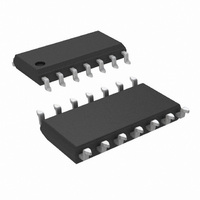LMV324M/NOPB National Semiconductor, LMV324M/NOPB Datasheet - Page 15

LMV324M/NOPB
Manufacturer Part Number
LMV324M/NOPB
Description
IC OP AMP QUAD LOW V R-R 14-SOIC
Manufacturer
National Semiconductor
Specifications of LMV324M/NOPB
Amplifier Type
General Purpose
Number Of Circuits
4
Output Type
Rail-to-Rail
Slew Rate
1 V/µs
Gain Bandwidth Product
1MHz
Current - Input Bias
15nA
Voltage - Input Offset
1700µV
Current - Supply
410µA
Current - Output / Channel
160mA
Voltage - Supply, Single/dual (±)
2.7 V ~ 5.5 V
Operating Temperature
-40°C ~ 85°C
Mounting Type
Surface Mount
Package / Case
14-SOIC (3.9mm Width), 14-SOL
Bandwidth
1 MHz
Common Mode Rejection Ratio
65
Current, Input Bias
15 nA
Current, Input Offset
5 nA
Current, Output
60 mA
Current, Supply
410 μA
Impedance, Thermal
145 °C/W
Number Of Amplifiers
Quad
Package Type
SOIC-14
Temperature, Operating, Range
-40 to +85 °C
Voltage, Gain
100 V/mV
Voltage, Input
2.7 to 5.5 V
Voltage, Noise
39 nV/sqrt Hz
Voltage, Offset
1.7 mV
Voltage, Supply
5 V
Lead Free Status / RoHS Status
Lead free / RoHS Compliant
-3db Bandwidth
-
Lead Free Status / Rohs Status
RoHS Compliant part
Electrostatic Device
Other names
*LMV324M
*LMV324M/NOPB
LMV324M
*LMV324M/NOPB
LMV324M
Available stocks
Company
Part Number
Manufacturer
Quantity
Price
Company:
Part Number:
LMV324M/NOPB
Manufacturer:
IDT
Quantity:
112
Instrumentation Circuits
The input impedance of the previous difference amplifier is
set by the resistors R
lems of low input impedance, one way is to use a voltage
follower ahead of each input as shown in the following two
instrumentation amplifiers.
Three-Op-Amp Instrumentation Amplifier
The quad LMV324 can be used to build a three-op-amp in-
strumentation amplifier as shown in
The first stage of this instrumentation amplifier is a differential-
input, differential-output amplifier, with two voltage followers.
These two voltage followers assure that the input impedance
is over 100 MΩ. The gain of this instrumentation amplifier is
set by the ratio of R
R
good CMRR over temperature, low drift resistors should be
used. Making R
pot equal to twice the difference between R
the CMRR to be adjusted for optimum performance.
Two-Op-Amp Instrumentation Amplifier
A two-op-amp instrumentation amplifier can also be used to
make a high-input-impedance DC differential amplifier
ure
amplifier requires precise resistor matching for good CMRR.
R
2
4
FIGURE 8. Three-Op-Amp Instrumentation Amplifier
. Matching of R
should equal R
9). As in the three-op-amp circuit, this instrumentation
4
3
slightly smaller than R
1
to R
and, R
2
1
/R
, R
1
1
. R
2
and R
, R
3
3
should equal R
3
should equal R
, and R
4
to R
Figure
4
2
. To eliminate the prob-
affects the CMRR. For
2
and adding a trim
2
8.
2
and R
.
1
, and R
4
will allow
10006085
4
equal
(Fig-
15
Single-Supply Inverting Amplifier
There may be cases where the input signal going into the
amplifier is negative. Because the amplifier is operating in
single supply voltage, a voltage divider using R
implemented to bias the amplifier so the input signal is within
the input common-mode voltage range of the amplifier. The
capacitor C
R
V
1/2
As a result, the output signal is centered around mid-supply
(if the voltage divider provides V
The output can swing to both rails, maximizing the signal-to-
noise ratio in a low voltage system.
IN
1
FIGURE 9. Two-Op-Amp Instrumentation Amplifier
. The values of R
π
to block the DC signal going into the AC signal source,
R
FIGURE 10. Single-Supply Inverting Amplifier
1
C
1
.
1
is placed between the inverting input and resistor
1
and C
1
affect the cutoff frequency, fc =
+
10006020
/2 at the non-inverting input).
10006013
10006035
www.national.com
3
and R
10006011
4
is












